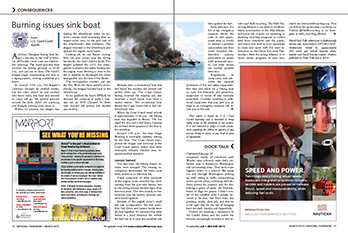Burning issues sink boat
From U.S. Coast Guard reports
A 46-foot, fiberglass fishing boat began a day-trip in the Gulf of Mexico off Florida’s west coast one September morning. The hook-and-line boat reached the fishing grounds at 10:30 a.m., and put out its lines. The vessel’s skipper began maneuvering the boat in a zigzag pattern, moving northwest at 4 knots.
At around 11:30 a.m., the skipper’s crewman thought he smelled smoke, but the odor, which he said smelled like burnt toast, was faint and seemed to come and go. He quickly glanced around the deck, didn’t see anything and thought nothing more about it.
Within 45 minutes, the skipper was leaving the wheelhouse when he noticed a smoky smell emanating from an engine-room vent on the port side of the wheelhouse’s after bulkhead. The skipper returned to the wheelhouse and opened the engine-room hatch.
Looking aft, he saw flames coming from the port corner near the wiring harness for the boat’s battery banks. The skipper grabbed the CO2 fire extinguisher located by the ladder leading into the engine room. Moving as close to the fire as possible, he discharged the entire extinguisher into the base of the flames.
The extinguisher couldn’t put out the fire. With the blaze quickly intensifying, the skipper hurried back to the wheelhouse.
As he grabbed the boat’s EPIRB, he directed the crewman to make a mayday call on VHF Channel 16. Both men donned life jackets and headed out on deck.
Minutes later, a recreational boat that had heard the mayday call arrived and picked them up. The Coast Guard, having received the mayday call, also launched a small rescue boat from a nearby station. The recreational boat alerted the Coast Guard that it had collected both men.
When the Coast Guard vessel arrived at approximately 12:50 p.m., the fishing boat was engulfed in flames. The fire raged for two and a half hours, burning the forward three-quarters of the boat to the waterline.
Around 2:45 p.m., the boat began flooding; it eventually capsized, sinking by the bow. The Coast Guard transported the skipper and crewman to the Coast Guard station, where they were eventually released. Neither man required medical attention.
Lessons learned
Ten days later, the fishing vessel’s remains were salvaged. The ensuing investigation determined the blaze most likely started as an electrical fire.
Visual inspection of what remained of the engine room revealed that wires running from the port-side battery box to the wiring harness showed signs of an electrical short. The wire strands, in two locations near the battery terminal end, were fused together.
Because of the engine room’s small size and configuration, the fuel manifold, fuel filters and battery banks were all close together. It’s surmised that what started as a small electrical fire melted the fuel line at or near the manifold and then ignited the fuel.
Early detection of a fire or any emergency situation allows the crew to take appropriate steps to rectify or mediate a problem and possibly save their vessel. Installed fire-detection systems, particularly on vessels with unmanned spaces, can help ensure the earliest possible detection.
Regulations, in many cases, only prescribe the required minimum of fire and safety equipment. But they also allow for a fishing boat to carry fire-detection and protection equipment in excess of that normally prescribed.
Consider investing in additional equipment that may give you an edge in an emergency situation and allow you to fish safe.
» Read more Consequences here.
» Read more articles in our MARCH issue







